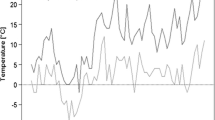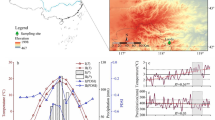Abstract
Key Message
Frost-sensitive and frost-resistant Cerrado tree species differ in their morphological and physiological traits, which are linked with their resprout strategies and can affect their persistence under recurrent frost events.
Abstract
Although fire is the most common disturbance affecting neotropical savannas, frost events are locally common and are sometimes severe enough to cause dieback of savanna trees at their southern limit of distribution. However, it is yet to be elucidated how physiology and morphology determine which species are frost sensitive. In this study, we evaluated morphological and physiological responses of trees to controlled low temperatures and to a severe frost event that occurred in 2016 at savanna sites of Southeastern Brazil. We determined the degree of bud protection, branch bark thickness, resprout strategies, and recovery of height and biomass 1 year after frost occurrence, and we performed an experiment to measure the photosynthetic capacity of leaves after exposure to low temperatures. We found that frost-sensitive species had unprotected buds, but were able to recover their lost biomass 1 year after frost. Frost-resistant species had buds with a greater degree of protection and maintained higher photosynthetic capacity under sub-zero temperatures. We did not find any differences in bark thickness between frost-resistant and frost-sensitive species. Frost-resistant and frost-sensitive species had different strategies to persist under frost events; however, if frost were more frequent, it could severely affect the height and carbon gain of sensitive species.





Similar content being viewed by others
References
Agrawal AA, Conner JK, Stinchcombe JR (2004) Evolution of plant resistance and tolerance to frost damage. Ecol Lett 7:1199–1208. https://doi.org/10.1111/j.1461-0248.2004.00680.x
Archibald S (2016) Managing the human component of fire regimes: lessons from África. Phil Trans R Soc. https://doi.org/10.1098/rstb.2015.0346
Archibald S, Roy DP, van Wilgen BW, Scholes RJ (2009) What limits fire? An examination of drivers of burnt area in Southern Africa. Glob Chang Biol 15:613–630. https://doi.org/10.1111/j.1365-2486.2008.01754.x
Bannister P (2007) Godley review: a touch of frost? Cold hardiness of plants in the southern hemisphere. N Z J Bot 45:1–33. https://doi.org/10.1080/00288250709509700
Beikircher B, Mittmann C, Mayr S (2016) Prolonged soil frost affects hydraulics and phenology of apple trees. Front Plant Sci. https://doi.org/10.3389/fpls.2016.00867
Bellingham PJ, Sparrow AD (2000) Resprouting as a life history strategy in woody plant communities. Oikos 89:409–416. https://doi.org/10.1034/j.16000706.2000.890224.x
Bojórquez A, Álvarez JC, Yrízar AM (2019) Understanding and predicting frost—induced tropical tree mortality patterns. Global Change Biol. https://doi.org/10.1111/gcb.14775
Bond WJ, Keeley JE (2005) Fire as a global “herbivore”: The ecology and evolution of flammable ecosystems. Trends Ecol Evol 20:387–394. https://doi.org/10.1016/j.tree.2005.04.025
Bond WJ, Midgley JJ (2001) Ecology of sprouting in woody plants: the persistence niche. Trends Ecol Evol 16:45–51. https://doi.org/10.1016/S0169-5347(00)02033-4
Bond WJ, Midgley GF, Woodward FI (2003) What controls South African vegetation - Climate or fire? South African. J Bot 69:79–91. https://doi.org/10.1016/S0254-6299(15)30362-8
Botha M, Archibald S, Greve M (2020) What drives grassland-forest boundaries? Assessing fire and frost effects on tree seedling survival and architecture. Ecol Evol 10(19):10719–10734. https://doi.org/10.1002/ece3.6730
Brando PM, Durigan G (2005) Changes in Cerrado Vegetation after Disturbance by Frost (São Paulo State, Brazil). Plant Ecol 175:205–215. https://doi.org/10.1007/s11258-005-0014-z
Brush RA, Griffith M, Mlynarz A (1994) Characterization and quantification of intrinsic ice nucleators in winter rye (Secale cereale) leaves. Plant Physiol 104(2):725–735. https://doi.org/10.1104/pp.104.2.725
Bueno ML, Pennington RT, Dexter KG, Kamino LHY, Pontara V, Neves DM, de Oliveira-Filho AT (2016) Effects of Quaternary climatic fluctuations on the distribution of Neotropical savanna tree species. Ecography 40(3):403–414. https://doi.org/10.1111/ecog.01860
Burrows GE, Hornby SK, Waters DA, Bellairs SM, Prior LD, Bowman DMJS (2010) A wide diversity of epicormic structures is present in Myrtaceae species in the northern Australian savanna biome—implications for adaptation to fire. Aust J Bot Bot 58:493–507. https://doi.org/10.1071/BT10107
Charles-Dominique T, Beckett H, Midgley GF, Bond WJ (2015) Bud protection: a key trait for species sorting in a forest-savanna mosaic. New Phytol 207:1052–1060. https://doi.org/10.1111/nph.13406
Clarke PJ, Lawes MJ, Midgley JJ, Lamont BB, Ojeda F, Burrows GE, Enrigh NJ, Knox KJE (2013) Resprouting as a key functional trait: How buds, protection and resources drive persistence after fire. New Phytol 197:19–35. https://doi.org/10.1111/nph.12001
Close DC, Beadle CL, Brown PH, Holz GK (2000) Cold-induced photoinhibition affects establishment of Eucalyptus nitens (Deane and Maiden) Maiden and Eucalyptus globulus Labill. Trees 15(1):32–41. https://doi.org/10.1007/s004680000070
Damascos MA, Prado CHBA, Ronquim CC (2005) Bud composition, branching patterns and leaf phenology in Cerrado woody species. Ann Bot 96:1075–1084. https://doi.org/10.1093/aob/mci258
Davies TJ, Daru BH, van der Bank M et al (2016) Multiple routes underground? Frost alone cannot explain the evolution of underground trees. New Phytol 209:910–912. https://doi.org/10.1111/nph.13795
De Antonio AC, Scalon MC, Rossatto DR (2020) The role of bud protection and bark density in frost resistance of savanna trees. Plant Biol 22:55–61. https://doi.org/10.1111/plb.13050
de Moraes MG, Carvalho MAM, Franco AC, Pollock CJ, Figueiredo-Ribeiro RCN (2016) Fire and drought: soluble carbohydrate storage and survival mechanisms in herbaceous plants from the Cerrado. Bioscience 66:107–117. https://doi.org/10.1093/biosci/biv178
Duker R, Cowling RM, du Preez DR, van der Vyver ML, Weatherall-Thomas CR, Potts AJ (2015) Community-level assessment of freezing tolerance: frost dictates the biome boundary between Albany subtropical thicket and Nama-Karoo in South Africa. J Biogeogr 42(1):167–178. https://doi.org/10.1111/jbi.12415
Ehlert B, Hincha DK (2008) Chlorophyll fluorescence imaging accurately quantifies freezing damage and cold acclimation responses in Arabidopsis leaves. Plant Methods 4(1):12. https://doi.org/10.1186/1746-4811-4-12
Enright NJ, Fontaine JB, Westcott VC, Lade JC, Miller BP (2011) Fire interval effects on persistence of resprouter species in Mediterranean-type shrublands. Plant Ecol 212:2071–2083. https://doi.org/10.1007/s11258-011-9970-7
Esau K (1967) Plant anatomy, 2d edn. Wiley, New York
Filgueiras TS, Pereira BAS (1987) Efeito de uma geada sobre a flora do cerrado na Reserva Ecológica do IBGE, DF - Brasil. Cadernos De Geociências 2:67–70
Finckh M (2016) Letters Climate refugees going underground—a response to Maurin et al. (2014). New Phytol 209:904–909. https://doi.org/10.1111/nph.13567
Franco AC, Bustamante M, Caldas LS et al (2005) Leaf functional traits of Neotropical savanna trees in relation to seasonal water deficit. Trees Struct Funct 19:326–335. https://doi.org/10.1007/s00468-004-0394-z
Gignoux J, Clobert J, Menaut JC (1997) Alternative fire resistance strategies in savanna trees. Oecologia 110:576–583. https://doi.org/10.1007/s004420050198
Hacke UG, Sperry JS (2001) Functional and ecological xylem anatomy. Perspect Plant Ecol 4(2):97–115. https://doi.org/10.1078/1433-8319-00017
Hempson GP, Midgley JJ, Lawes MJ, Vickers KJ, Kruger LM (2014) Comparing bark thickness: testing methods with bark—stem data from two South African fire-prone biomes. J Veg Sci 25:1247–1256. https://doi.org/10.1111/jvs.12171
Hoffmann WA (1998) Post-burn reproduction of woody plants in a neotropical savanna the relative importance of sexual and vegetative reproduction. J Appl Ecol 35:422–433. https://doi.org/10.1046/j.1365-2664.1998.00321.x
Hoffmann WA, Orthen B, Do Nascimento PKV (2003) Comparative fire ecology of tropical savanna and forest trees. Funct Ecol 17:720–726. https://doi.org/10.1111/j.1365-2435.2003.00796.x
Hoffmann WA, Adasme R, Haridasan M, De Carvalho MT, Geiger EL, Pereira MAB (2009) Tree top kill, not mortality, governs the dynamics of savanna-forest boundaries under frequent fire in central Brazil. Ecology 90:1326–1337. https://doi.org/10.1890/08-0741.1
Hoffmann WA, Flake SW, Abreu RCR, Pilon NAL, Rossatto DR, Durigan G (2019) Rare frost events reinforce tropical savanna-forest boundaries. J Ecol. https://doi.org/10.1111/1365-2745.13047
Holdo RM (2006) Tree growth in an African woodland savanna affected by disturbance. J Veg Sci 17:369–378. https://doi.org/10.1111/j.1654-1103.2006.tb02457.x
Holdo RM (2007) Elephants, fire, and frost can determine community structure and composition in Kalahari Woodlands. Ecol Appl 17:558–568. https://doi.org/10.1890/05-1990
Huner NP, Öquist G, Hurry VM, Krol M, Falk S, Griffith M (1993) Photosynthesis, photoinhibition and low temperature acclimation in cold tolerant plants. Photosynth Res 37(1):19–39. https://doi.org/10.1007/BF02185436
Joshi AA, Ratnam J, Sankaran M (2019) Frost maintains forests and grasslands as alternate states in a montane tropical forest–grassland mosaic; but alien tree invasion and warming can disrupt this balance. J Ecol 108(1):122–132. https://doi.org/10.1111/1365-2745.13239
Lawes MJ, Adie H, Russell-Smith J, Murphy B, Midgley JJ (2011) How do small savanna trees avoid stem mortality by fire? The roles of stem diameter, height and bark thickness. Ecosphere 2(4):1–13. https://doi.org/10.1890/ES10-00204.1
Lawes MJ, Midgley JJ, Clarke PJ (2013) Costs and benefits of relative bark thickness in relation to fire damage: a savanna/forest contrast. J Ecol 101:517–524. https://doi.org/10.1111/1365-2745.12035
Lehmann CER, Archibald SA, Hoffmann WA, Bond WJ (2011) Deciphering the distribution of the savanna biome. New Phytol 191:197–209. https://doi.org/10.1111/j.1469-8137.2011.03689.x
Martínez-Vilalta J, Sala A, Asensio D, Galiano L, Hoch G, Palacio S, Piper FI, Lloret F (2016) Dynamics of non-structural carbohydrates in terrestrial plants: a global synthesis. Ecol Monogr 86(4):495–516. https://doi.org/10.1002/ecm.1231
Melo AC, Durigan G (2011) Plano de Manejo da Estação Ecológica de Santa Bárbara. Instituto Florestal, São Paulo
Midgley JJ, Lawes MJ, Chamailĺ-Jammes S (2010) Savanna woody plant dynamics: the role of fire and herbivory, separately and synergistically. Aust J Bot 58:1–11. https://doi.org/10.1071/BT09034
Miranda AC, Miranda HS, Dias IFO, Dias BFS (1993) Soil and air temperatures during prescribed cerrado fires in Central Brazil. J Trop Ecol 9:313–320. https://doi.org/10.1017/S0266467400007367
Muller K, O’Connor TG, Henschel JR (2016) Impact of a severe frost event in 2014 on woody vegetation within the Nama-Karoo and semi-arid savanna biomes of South Africa. J Arid Environ 133:112–121. https://doi.org/10.1016/j.jaridenv.2016.06.010
Niklas KJ (1999) The mechanical role of Bark. Am J Bot 86:465–469
Pausas JG (2015) Bark thickness and fire regime. Funct Ecol 29:315–327. https://doi.org/10.1111/nph.14277
Pausas JG, Ribeiro E (2017) Fire and plant diversity at the global scale. Glob Ecol Biogeogr 26:889–897. https://doi.org/10.1111/geb.12596
Ratnam J, Chengappa SK, Machado SJ, Nataraj N, Osuri AM, Sankaran M (2019) Functional traits of trees from dry deciduous “forests” of southern India suggest seasonal drought and fire are important drivers. Front Ecol Evol. https://doi.org/10.3389/fevo.2019.00008
Rossatto DR, Hoffmann WA, de Carvalho Ramos Silva L et al (2013) Seasonal variation in leaf traits between congeneric savanna and forest trees in Central Brazil: Implications for forest expansion into savanna. Trees Struct Funct 27:1139–1150. https://doi.org/10.1007/s00468-013-0864-2
Sakai A, Larcher W (1987) Mechanisms of frost survival. Ecol Stud 62:317. https://doi.org/10.1007/978-3-642-71745-1
Scalon MC, Domingos FMCB, Cruz WJA, Júnior BHM, Marimon BS, Oliveras I (2020) Diversity of functional trade-offs enhances survival after fire in Neotropical savanna species. J Veg Sci. https://doi.org/10.1111/jvs.12823
Silberbauer-Gottsberger I, Morawetz W, Gottsberger G (1977) Frost damage of cerrado plants in Botucatu, Brazil, as related to the geographical distribution of the species. Biotropica 9:253–261. https://doi.org/10.2307/2388143
Vanoni M, Bugmann H, Nötzli M, Bigler C (2016) Drought and frost contribute to abrupt growth decreases before tree mortality in nine temperate tree species. For Ecol Manag 382:51–63. https://doi.org/10.1016/j.foreco.2016.10.001
Vuono YS, Barbosa LM, Batista EA, Gurgel Filho OA (1982) Efeitos biológicos da geada na vegetação do cerrado. Silvicultura Em São Paulo 16A:545–547
Wakeling JL, Cramer MD, Bond WJ (2012) The savanna-grassland “treeline”: Why don’t savanna trees occur in upland grasslands? J Ecol 100:381–391. https://doi.org/10.1111/j.1365-2745.2011.01921.x
Whitecross MA, Archibald S, Witkowski ETF (2012) Do freeze events create a demographic bottleneck for Colophospermum mopane. S Afr J Bot 83:9–18. https://doi.org/10.1016/j.sajb.2012.07.008
Acknowledgements
This study was financed in part by the Coordenação de Aperfeiçoamento de Pessoal de Nível Superior-Brasil (CAPES)—Finance Code 001; Conselho Nacional de Desenvolvimento Cientifíco e Tecnológico (CNPq) grants 301589/2015-1 and 302897/2018-6 and National Science Foundation under Grant Number DEB1354943.
Author information
Authors and Affiliations
Corresponding author
Ethics declarations
Conflict of interest
The authors declare that they have no competing interests.
Additional information
Communicated by Franco.
Publisher's Note
Springer Nature remains neutral with regard to jurisdictional claims in published maps and institutional affiliations.
Supplementary Information
Below is the link to the electronic supplementary material.
Rights and permissions
About this article
Cite this article
De Antonio, A.C., Hoffmann, W.A. & Rossatto, D.R. The role of morpho-physiological traits in frost tolerance of neotropical savanna trees. Trees 35, 1687–1696 (2021). https://doi.org/10.1007/s00468-021-02150-7
Received:
Accepted:
Published:
Issue Date:
DOI: https://doi.org/10.1007/s00468-021-02150-7




